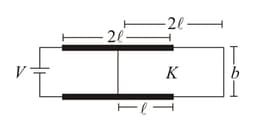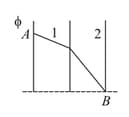A parallel plate isolated condenser consists of two metal plates of area and separation . A slab of thickness and dielectric constant is inserted between the plates with its faces parallel to the plates and having the same surface area as that of the plates. Find the capacitance of the system. If for what value of will the capacitance of the system be times that of the condenser with air filling the full space? Calculate the ratio of the energy in the two cases and account for the energy change (assuming charge on the plate to be constant).

Important Questions on Capacitance
Consider the situation shown in figure. The width of each plate is . The capacitor plates are rigidly clamped in the laboratory and connected to a battery of . All surface are frictionless. Calculate the extension in the spring in equilibrium (spring is nonconducting).

In figure shown, two parallel plate capacitors with fixed plates and connected to two batteries. The separation between the plates is same for the two capacitors. The plates are rectangular with width and lengths , the separation between plates is . The left half of the dielectric slab has a dielectric constant and the right half . EMF of the right battery is greater than left battery. Neglecting any friction, find the extension in spring in equilibrium (spring is nonconducting)

The plates of the parallel plate capacitor have plate area and are clamped in the laboratory as shown in figure. The dielectric slab of mass , length and width is released from rest with length inside the capacitor. Neglecting any effect of friction or gravity, show that the slab will execute periodic motion and find its time period. (plates of capacitor are square plates of side )

A parallel plate capacitor is filled with a dielectric up to one half of the distance between the plates. The manner in which the potential between the plates varies with distance is illustrated in the figure. Which half of the space between the plates is filled with the dielectric and what will be the distribution of the potential after the dielectric is taken out of the capacitor provided that

The charges on the plates are conserved or
The potential difference across the capacitor is constant.
Positive charge is given to each plate of a parallel plate air capacitor having area of each plate and separation between them, Then find
Capacitance of the system.
Charges appearing on each surface of plates
Electric field between the plates
Potential difference between the plates
Energy stored between the plates
The radii of two metallic spheres are and and both carry equal charge of . If the two spheres are shorted then charge will be transferred
